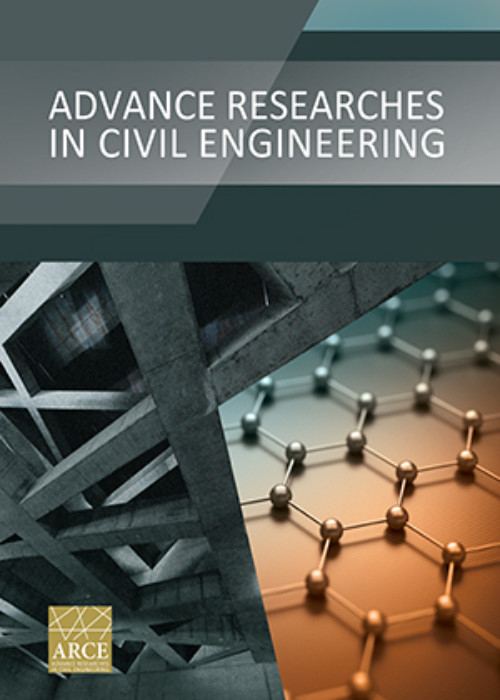فهرست مطالب

Advance Researches in Civil Engineering
Volume:4 Issue: 3, Summer 2022
- تاریخ انتشار: 1401/07/16
- تعداد عناوین: 5
-
Pages 1-10Considering the growth of industrialization for construction works, the role of on-site equipment and machinery in enhancing productivity and efficiency as well as improving working standards of construction. Hence, selecting the proper construction equipment is a challenging task owing to a wide range of available types as well as a host of criteria to be considered during decision making. However, the selection may result in incorrect decision-making or neglection of factors that are as important as cost or technical features. For this reason, nowadays the decision makers use multi-criteria decision making (MCDM) methods to make the most suitable or beneficial decision on machine and equipment selection. One of the most widely used construction equipment is wheel loader. This machine is widely used in all fields of construction. Therefore, proper selection based on the real needs of the project seems necessary. Hence, in this study, the selection of a suitable wheel loader was studied using MCDM methods. In this regard, an integrated approach using AHP and PROMETHEE method for evaluating wheel loader selection were used. In this regard, the Analytic Hierarchy Process (AHP) and the preference ranking organization method for enrichment evaluation (PROMETHEE), are used in the evaluation procedure. More precisely, AHP is applied to determine the relative weights of evaluation criteria and PROMETHEE is applied to rank the wheel loader alternatives. The proposed approach also provides a relatively simple and very well suited decision making tool for this type of decision making problems.Keywords: Wheel loader selection, AHP, PROMETHEE, MCDM, Construction equipment selection
-
Pages 11-21The East Africa black cotton soil (BCS) cannot be used as embankment filling directly, because it is high in clay content, liquid limit, plasticity index, and low in CBR strength (CBR < 3%). Therefore, this paper uses tests and analysis on the indicators, such as basic physical properties, swelling characteristics and mechanical properties of the East Africa BCS modified by the lime and volcanic ash, in order to explore the influence of the different blending amounts of lime, volcanic ash on expansion and contraction deformation strength and the law of change. So that the economical and feasible chemical treatments of the East Africa BCS which meet the requirements of specifications can be found. In addition, the chemical treatment mechanism of the East Africa BCS will be analyzed.Keywords: Road engineering, Black cotton soil, Base, lime, Volcanic ash
-
Pages 22-28Rapid developments of industrial and urban structures and infrastructures necessitate the utilization of remote or unsuitable lands that were not considered for construction in the past. The application of surcharge and prefabricated vertical drains (PVDs) is one the popular methods that is used all around the world as a result of simplicity and high efficiency. One of the issues that may occur in such reclamation projects, is the existence of sensitive infrastructures or structures in the vicinity of the treatment area. There are many variables that affect the diameter of the influence zone such as: the compressibility of weak layers, the height of clay stratums, length of the PVDs and the height of surcharge embankment and so on. In this literature the impact of spacing between PVDs was investigated using finite element modelling. Three test embankments as TS1, TS2 and TS3 were modeled and verified for the study. For TS1 (PVDs with 1.5 m spacing), TS2 (PVDs with 1.2 m spacing) and TS3 (PVDs with 1.0 m spacing) the diameters of the influence zone were 54.8, 46 and 42.3 m respectively. As the distance between the PVDs decreases, the influence zone decreases as well and becomes smaller. For the FEM simulation of only surcharge embankment in the absence of PVDs the influence zone after 400 days was 64 m in the case that only 0.65 settlement was reached. It can be seen that the inclusion of PVDs and the utilization of smaller quantities of spacing can be an effective way for the reduction of influence zones where there are concerns regarding adjacent structures or infrastructures.Keywords: PVDs, Influence zone, surcharge, Consolidation, Weak clays
-
Pages 29-38New generation concretes have specific properties, often obtained by using additives, and these properties are strongly affected by the rheological characteristics of the fresh cement paste. In this study, the effects of synthetic zeolite, and limestone on the rheological and mechanical properties of fresh concrete and mortars were investigated. Using self-compacting concrete (SCC) which is mainly known by high flow ability, good cohesiveness, and high segregation resistance has been increasing worldwide in concrete structures in recent years. Because of the extensive use of mineral admixtures in SCC the effect of these admixtures on the flow ability of cementitious mixtures should be studied. For this reason, in the preliminary investigation of this study six mortar mixtures with different W/C ratios were prepared and the optimum W/C for self-compacting was reported. Then W/C was selected at 0.45 and the effect of natural zeolite (NZ) and limestone powder (LP) on the fluidity, viscosity and stability of SCCs was investigated. The 28-day compressive and tensile strength of all the mixtures is also determined herein. The results indicate that NZ and LP improve the fluidity of the mixtures. NZ increases the viscosity while LP does not have a significant effect on the viscosity of SCCs. Furthermore, use of LP may improve the compressive strength of cementitious mixtures to some extent.Keywords: Self-Compacting Concrete, Rheology, Compressive strength, Natural zeolite, limestone powder
-
Pages 39-49Earth dams are sometimes built with large dimensions in order to produce electrical energy, control floods, supply drinking water and agriculture, etc. The failure of earth dams also causes irreparable economic and human losses, which increased the importance of designing and strengthening dams. The stability of earth dam mainly depends on the shear strength of the soil, and this resistance in earth dams is provided by the friction between soil particles. The greater the angle of internal friction between soil particles, the more the shear resistance of soil improves. As a result, the stability of dam increases. The issue of increasing the shear strength in the soil with using geosynthetics in the earth dam is the main goal of this research. The effect of geosynthetics and their arrangement, placement distance from each other, length, and materials used, including cohesion, unit weight and internal friction angle are the main research variables. In this research, by using geotextile in the earth dam body, the stability and safe and economical design of the dam in static and dynamic state under seismic load has been evaluated. For this purpose, Plexis software has been used.Keywords: Earth Dam, Geosynthetic, Static loading, Dynamic loading, Stability Analysis


